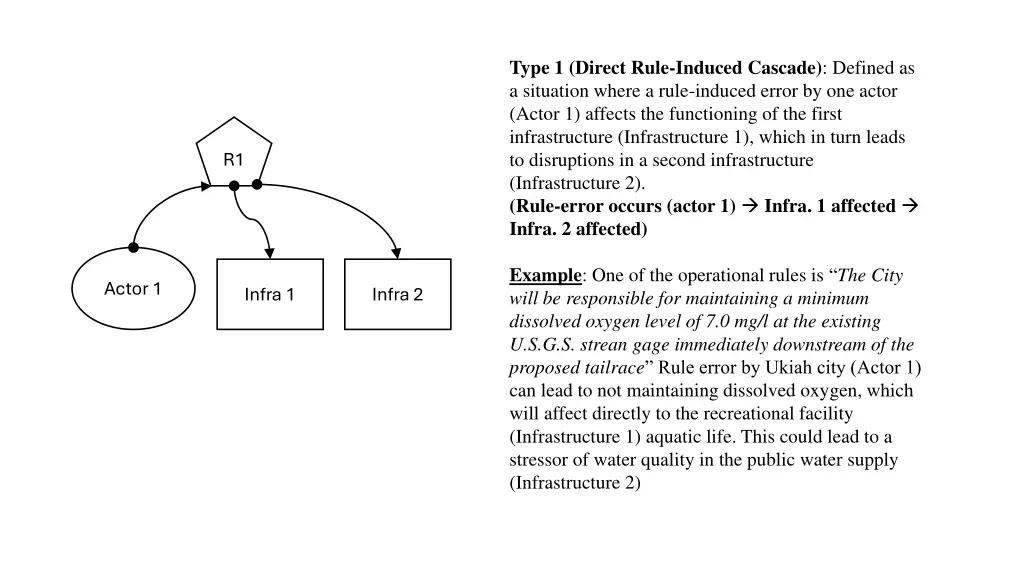
Understanding Rule-Induced Cascading Failures in Critical Infrastructures
Explore the three types of rule-induced cascades impacting critical infrastructures: direct, indirect, and hybrid logical. Learn how errors in operational rules can lead to disruptions, affecting interconnected systems and public services. Stay informed on the complexities of infrastructure interdependencies to mitigate risks effectively.
Download Presentation

Please find below an Image/Link to download the presentation.
The content on the website is provided AS IS for your information and personal use only. It may not be sold, licensed, or shared on other websites without obtaining consent from the author. If you encounter any issues during the download, it is possible that the publisher has removed the file from their server.
You are allowed to download the files provided on this website for personal or commercial use, subject to the condition that they are used lawfully. All files are the property of their respective owners.
The content on the website is provided AS IS for your information and personal use only. It may not be sold, licensed, or shared on other websites without obtaining consent from the author.
E N D
Presentation Transcript
Type 1 (Direct Rule-Induced Cascade): Defined as a situation where a rule-induced error by one actor (Actor 1) affects the functioning of the first infrastructure (Infrastructure 1), which in turn leads to disruptions in a second infrastructure (Infrastructure 2). (Rule-error occurs (actor 1) Infra. 1 affected Infra. 2 affected) R1 Example: One of the operational rules is The City will be responsible for maintaining a minimum dissolved oxygen level of 7.0 mg/l at the existing U.S.G.S. strean gage immediately downstream of the proposed tailrace Rule error by Ukiah city (Actor 1) can lead to not maintaining dissolved oxygen, which will affect directly to the recreational facility (Infrastructure 1) aquatic life. This could lead to a stressor of water quality in the public water supply (Infrastructure 2) Actor 1 Infra 1 Infra 2
Type 2 (Indirect Rule-Induced Cascade): Occurs when a rule-induced error by one actor (Actor 1) affects Infrastructure 1, which then either triggers another rule-based error by the same or a different actor (Actor 1 or 2), subsequently impacting Infrastructure (Rule-error occurs (actor 1) Infra. 1 affected Rule-error occurs (actor 1 or actor 2) Infra. 2 affected) 2. R1 R2 Example: Described rule All water releases from Coyote Dam will be determined by the Corps. If a rule error occurs and USACE (Actor 1) fails to provide the release schedule on time. It will affect reservoir operations since it may not receive the information feed. It will lead to a consequent rule error in Ukiah City (Actor 2). The rule states, The City, after receiving the flow release schedules, shall provide an operations program for that period. Without an operations program, the automated controller of the reservoir will not receive information feed. Actor 1 or 2 Actor 1 Infra 1 Infra 2
Type 3 (Hybrid Logical): Arises when a logical rule induced error (human decision by actor 1) triggers disruptions in Infrastructure 1 that propagate through either cyber, physical, or geographical interdependency to affect Infrastructure 2. (Rule-error occurs (actor 1) Infra. 1 affected Geographical or Cyber or Physical error Infra. 2 affected) Example:The rule is, When the dam and power plant facilities are operating in flood control mode, the turbines and bypass valves will be fully closed. Rule error by USACE (Actor 1) directly affects the turbine and generator (Infrastructure 1) of Coyote Valley Dam, due to geographical interdependency, it will affect the transmission lines of the power grid (Infrastructure 2).
References He, S., Zhou, Y., Yang, Y., Liu, T., Zhou, Y., Li, J., Wu, T., & Guan, X. (2024). Cascading Failure in Cyber Physical Systems: A Review on Failure Modeling and Vulnerability Analysis. IEEE Transactions on Cybernetics, 1 19. Rinaldi, S. M., Peerenboom, J. P., & Kelly, T. K. (2001a). Identifying, understanding, and analyzing critical infrastructure interdependencies. IEEE Control Systems Magazine, 21(6), 11 25. https://doi.org/10.1109/37.969131 Rostami, A., Mohammadi, M., & Karimipour, H. (2023). Reliability assessment of cyber-physical power systems considering the impact of predicted cyber vulnerabilities. International Journal of Electrical Power & Energy Systems, 147, 108892. https://doi.org/10.1016/J.IJEPES.2022.108892 Tu, H., Xia, Y., & Chen, X. (2022). Vulnerability analysis of cyber physical systems under the false alarm cyber attacks. Physica A: Statistical Mechanics and Its Applications, 599, 127416. https://doi.org/10.1016/J.PHYSA.2022.127416 Tu, T., Liao, Y., Li, X., Wang, L., F. Z.-I. G., & 2023, undefined. (2023). Vulnerability assessment of cyber physical power systems considering failure propagation: A percolation based approach. Wiley Online Library, 17(19), 4344 4358. https://doi.org/10.1049/gtd2.12967 Yu, D. J., Shin, H. C., Olivier, T., Garcia, M., Meerow, S., & Park, J. (2025). Logical interdependencies in infrastructure: What are they, how to identify them, and what do they mean for infrastructure risk analysis? Risk Analysis, 45(2), 356 375. https://doi.org/10.1111/RISA.16555






















